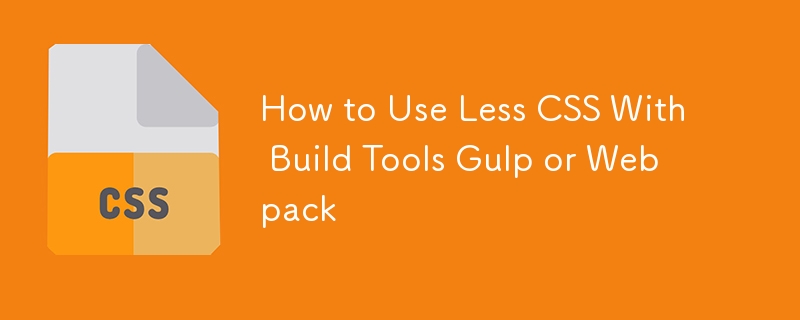

Integrating Less CSS with popular build tools such as Gulp or Webpack is a smart way to streamline your front-end development workflow. Less CSS is a highly functional preprocessor that extends standard CSS with features that make it easier to manage complex stylesheets and create more maintainable code.
Incorporating build tools automates repetitive tasks, such as compiling Less into standard CSS, minifying the output, and improving assets. These tools enhance productivity and maintain consistent code quality across your projects.
Learning to leverage them properly allows you to focus more on creative design and functionality without getting bogged down with manual processes.
Less is a CSS preprocessor that builds on traditional CSS's core capabilities by introducing features such as variables, nested rules, and mixins.
These additions streamline the styling process, making it more intuitive and maintainable. For example, variables allow you to define reusable values, and mixins enable you to include groups of CSS properties in other selectors.
Nested rules mirror the structure of your HTML, providing a clearer and more organized codebase. Using Less simplifies theme management and reduces stylesheet redundancy, allowing for more efficient and flexible design changes.
To set up Less CSS in your development environment, begin by installing Node.js and npm (Node Package Manager), which are necessary for managing packages and dependencies.
Proper setup is important for seamless integration with build tools such as Gulp or Webpack. It allows for efficient compilation, optimization, and management of your stylesheets. Establishing a solid foundation helps maintain a smooth workflow and prevents potential issues during development.
Gulp is a powerful task runner that automates various development workflows, streamlining the management of repetitive tasks.
To set up Gulp in a project, start by installing it globally using ‘npm install -g gulp-cli’ and then as a development dependency with ‘npm install gulp --save-dev’. Next, create a gulpfile.js in the root directory to define the tasks Gulp will perform.
To better illustrate what I’m talking about here, imagine a real-world scenario where you're developing a complex web application. You need to regularly compile Less files into CSS, optimize the output, and confirm the styles are applied correctly.
Gulp can automate these tasks by setting up a process that compiles your Less files into CSS whenever changes are detected. It can also minify the CSS to reduce file size further and generate source maps for easier debugging.
For example, when trying to develop a new feature, you might update styles across several Less files. With Gulp, as soon as you save these changes, it will automatically compile the Less files, compress the resulting CSS, and place it in the designated directory.
Gulp's simplicity and flexibility make it a valuable tool for handling various tasks, from compiling and minifying CSS to facilitating live reloading during development.
Webpack is a versatile module bundler that efficiently manages assets in a web project, from JavaScript and CSS to images and fonts.
Setting up Webpack involves installing it via npm with ‘npm install webpack webpack-cli --save-dev’ and adding the necessary loaders to handle Less files. For Less, you'll need to ‘install less-loader’, ‘css-loader’, and ‘style-loader’ using npm.
To configure Webpack for compiling Less into CSS, create a ‘webpack.config.js; file in your project's root directory. In this configuration, define an entry point for your Less files and set up the rules to use your installed loaders.
The ‘less-loader’ compiles Less into CSS, ‘css-loader’ interprets ‘@import’ and ‘url()’ such as ‘import/require()’, and style-loader injects the CSS into the DOM. You can also use plugins such as MiniCssExtractPlugin to extract CSS into separate files and css-minimizer-webpack-plugin to optimize the output.
One standout feature of Webpack is hot module replacement, or HMR, which allows you to see changes in real-time without refreshing the browser. It significantly speeds up development by instantly reflecting style changes, making it easier to fine-tune your design.
In Less, advanced techniques such as using variables and mixins can significantly enhance your code's reusability and maintain consistent styling across your project.
Integral to the development process, testing and debugging allows you to catch problems early on and, as a result, provide a better user experience.
Linting your CSS is important for maintaining proper code quality and keeping it consistent over time. Tools such as stylelint are great for spotting errors and keeping your codebase clean. For debugging, browser developer tools are incredibly useful, allowing you to inspect elements and address styling issues.
Source maps also come in handy, linking the compiled CSS back to the original Less code, which makes tracking down problems much easier.
When deploying a project for production, it's important to focus on performance optimization to enhance the user experience.
Start by minifying CSS to reduce file sizes and resulting load times on your pages or applications. Consider enabling gzip compression on your server to compress files further and speed up delivery. You can also leverage browser caching by setting proper cache headers so returning visitors can load your site more quickly.
The above is the detailed content of How to Use Less CSS With Build Tools Gulp or Webpack. For more information, please follow other related articles on the PHP Chinese website!




